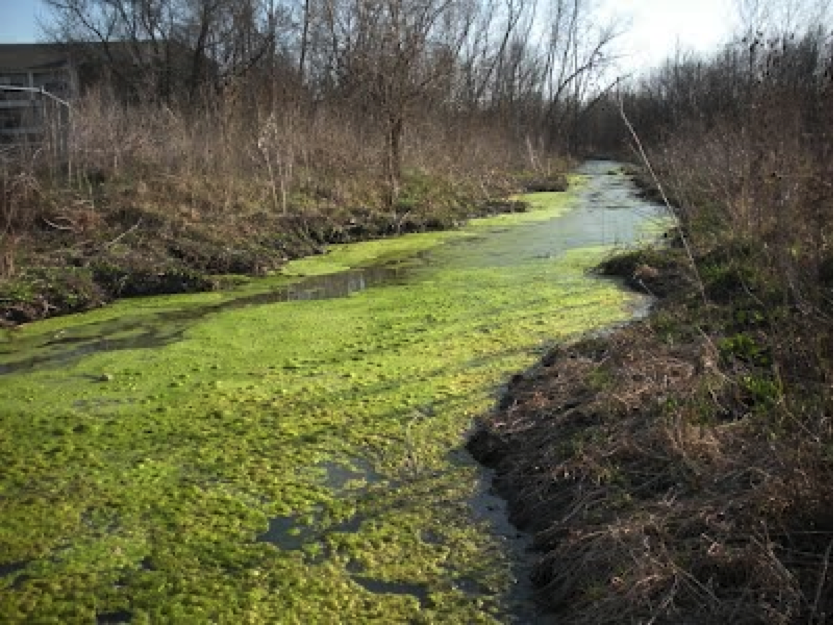Click here for a summary of Friends of the Kaw’s action on nutrient regulation
How to Test Your Pond for Blue Green Algae
Information on Harmful Algae Blooms (HABs) from EPA
The nutrients nitrogen and phosphorus are found naturally in low quantities in healthy water systems, and are essential for aquatic plants and other forms of aquatic life. Nitrogenous compounds, such as nitrite, nitrate, and ammonia, are the basic building blocks for protein synthesis, while phosphorus serves as an energy source in cellular chemical reactions. Large inputs of these nutrients, however, can unbalance an aquatic system, leading to such undesirable consequences as eutrophication (excessive nutrient enrichment) and algal blooms (see picture at right).
Algae often out-compete other aquatic plants and use the excessive nutrients to fuel a population explosion. The consequences of algal blooms include taste-and-odor problems in drinking water, and reduction of the aesthetic and recreational value of water. Eventually the algal bloom will die, and as the organic matter decays, it uses up oxygen. Decomposition of such a large amount of plant material takes up much of the dissolved oxygen in the aquatic system, further stressing fish and other aquatic organisms.
New EPA web site on nutrient pollution policy: http://epa.gov/nandppolicy
New EPA web site on nutrient pollution for homeowners, students, and educators: http://epa.gov/nutrientpollution
Fecal coliform are a group of bacteria that can include any combination of Escherichia coli (E. coli) and species of the Klebsiella, Enterobacter, and Citro bacter genera. Fecal coliform, including E. coli, are found in the intestinal tracts of warmblooded animals, including humans and livestock. The presence of large concentrations of these types of bacteria in surface water indicates fecal contamination and also may indicate the presence of disease-causing organisms. Fecal coliform is often tested for as an indicator of the potential presence of other pathogens associated with the digestive systems of humans and other animals.
E. coli is the dominant bacteria of the fecal coliform group. Most strains are harmless and live in the intestines of healthy humans and animals; however a few strains result in mild to serious illness. A few strains, including E. coli O157:H7, produce a powerful toxin and can cause severe illness. Outbreaks of E. coli in food or drinking water that cause serious illness are usually attributable to E. coli O157:H7.
A major source of nutrients in the Kansas River basin includes agricultural operations which use nitrogen-based fertilizers, including anhydrous ammonia, ammonium nitrate, urea, and mono- and diammonium phosphates. The amount of fertilizer sold in Kansas has significantly increased over the last four decades. In 1950, about 180,000 tons of fertilizer were sold in Kansas; by 2009 sales increased to about 1,233,870 tons during a 6-month period (January through June 2009). It is reasonable to assume that the amount of fertilizer applied to cropland in the Kansas River basin has also increased.
Livestock, especially confined animal feeding operations (CAFOs) also contribute substantial amounts of nitrogenous waste (urine and manure) and fecal coliform bacteria, including E. coli. Studies on the Kansas River have shown that the concentration of nutrients, total dissolved solids and bacteria increase substantially during heavy rain. This is due to overland runoff washing the fertilizers and animal waste into the river and its tributaries.
Wastewater treatment plants discharging directly into the Kansas River and its tributaries often contain some concentration of nutrients. Wastewater effluents are substantial sources of phosphorus in surface water because phosphorus is essential in metabolism and is present in human and animal metabolic waste. Wastewater Treatment Plants are required to treat wastewater to kill bacteria before discharging the effluent into streams or rivers, by using either chlorination, ultra-violet light, or ozone. However some strains of fecal coliform bacteria have been shown to persist through the wastewater treatment process. It is extremely important to keep Wastewater Treatment Plants maintained and functioning properly, to decrease the amount of contaminants discharging into the River. (See Wastewater Treatment Plants for more information)
Sources:
Gleeson, C., and Gray, N.F., 1997, The coliform index and waterborne disease—problems of microbial drinking water assessment: London, E. and F.N. Spon, LTD., 210 p.
Holt, J.G., Krieg, N.R., Sneath, P.H.A., and others, eds., 1993, Bergey’s manual of determinative bacteriology (9th ed.): Baltimore, Maryland, Williams and Wilkens, 787 p.
“2012 Fertilizer Report” Kansas Department of Agriculture.
Rasmussen, P.P., and Ziegler, A.C., 2003, Comparison and continuous estimates of fecal coliform and Escherichia coli bacteria in selected Kansas streams, May 1999 through April 2002: U.S. Geological Survey Water-Resources Investigations Report 03–4056, 80 p.
Rasmussen, T.J., Ziegler, A.C., and Rasmussen, P.P., 2005, Estimation of constituent concentrations, densities, loads, and yields in lower Kansas River, northeast Kansas, using regression models and continuous water-quality monitoring, January 2000 through December 2003: U.S. Geological Survey Scientific Investigations Report 2005–5165, 117 p.
Schmidt, H.C.R., Mehl, H.E., and Pope, L.M., 2007, Water quality on the Prairie Band Potawatomi Reservation, northeastern Kansas, June 1996 through August 2006: U.S. Geological Survey Scientific Investigations Report 2007–5201, 75 p.

